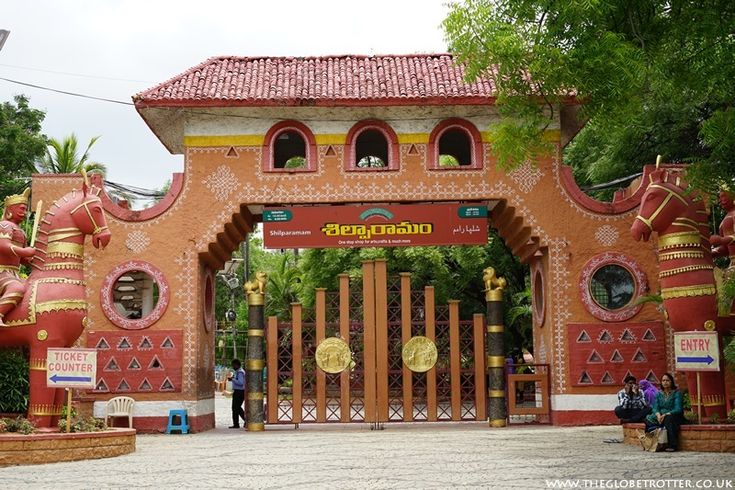In the bustling tech hub of Hyderabad, where glass-and-steel structures dominate the skyline and IT professionals hurry through their day, lies a peaceful sanctuary that feels like stepping back in time. Shilparamam, which translates to “sculptor’s village,” is a cultural oasis that preserves and celebrates the rich artistic heritage of India. Located in the upscale area of Madhapur, near HITEC City, this arts and crafts village offers visitors a refreshing break from urban life and a chance to reconnect with traditional Indian craftsmanship.
Table of Contents
The Origins of Shilparamam

Established in 1992 by the Government of Telangana (then part of Andhra Pradesh), Shilparamam was created with a dual purpose: to preserve the dying arts and crafts of the region and to provide artisans with a platform to showcase and sell their work. Spread across 65 acres of beautifully landscaped grounds, this cultural village stands as a testament to India’s commitment to protecting its artistic heritage in the face of rapid modernization.
The name itself reveals its purpose – “Shilpa” refers to arts and crafts, while “Ramam” means a place where people gather. True to its name, Shilparamam has become a gathering place for artists, craftspeople, and culture enthusiasts from across the country.
A Living Museum of Rural Life

What makes Shilparamam unique is that it’s not just a static museum but a living, breathing recreation of rural Indian life. The village is designed to represent a traditional Indian village, complete with mud houses, thatched roofs, and artisans working in their natural environment.
As you enter the village, you’re greeted by life-sized sculptures depicting rural scenes – women drawing water from wells, farmers tilling the land, and children playing traditional games. These tableaus offer urban dwellers and international tourists a glimpse into the simplicity and charm of village life in India.
The Crafts Bazaar: A Treasure Trove of Artistry

The heart of Shilparamam is undoubtedly its permanent crafts bazaar, where artisans from various states display their creations. Unlike commercial markets, here you can often watch the artists at work, using techniques passed down through generations.
The bazaar features a dazzling array of handicrafts:
- Pochampally and Gadwal silk sarees from Telangana, known for their distinctive geometric patterns
- Kalamkari paintings from Andhra Pradesh, where artists use natural dyes to create intricate mythological scenes
- Bidriware from Karnataka, a metal craft with silver inlay work on blackened metal
- Kondapalli toys from Andhra Pradesh, brightly painted wooden figures
- Nirmal paintings from Telangana, recognized for their vibrant colors and gold highlights
- Dokra metal casting from tribal regions, featuring brass figurines made using the lost-wax technique
- Banjara embroidery with mirror work and colorful threads
What makes shopping here special is the opportunity to interact directly with the artisans, learning about their techniques and the cultural significance behind their creations. Many visitors find themselves captivated by stories of crafts that have been practiced in the same family for hundreds of years.
Cultural Performances That Bring Traditions Alive
Shilparamam isn’t just about visual arts – it’s a feast for all senses. The open-air theater regularly hosts performances of classical dance forms like Kuchipudi, Bharatanatyam, and Kathak, as well as folk dances from various regions of India.
During festivals and special occasions, the cultural village comes alive with music, dance, and theatrical performances. These events not only entertain but also serve an educational purpose, introducing younger generations to art forms that might otherwise fade into obscurity.
The Night Bazaar: Magic Under the Stars
A relatively recent addition to Shilparamam is its Night Bazaar, which operates from late afternoon until night. With twinkling lights, the sound of folk music in the air, and the aroma of traditional foods wafting from food stalls, the Night Bazaar creates a magical atmosphere.
Here, visitors can shop for handicrafts, sample regional cuisines, and enjoy cultural performances – all under the starlit sky. The Night Bazaar has become particularly popular among locals looking for a peaceful evening outing away from the city’s noise and traffic.
A Natural Retreat Within the City
Beyond arts and crafts, Shilparamam offers beautiful landscaped gardens, a rock museum, and a tranquil lake. Stone pathways wind through the village, leading visitors past flowering shrubs, medicinal plant gardens, and shaded rest areas.
The rock museum displays interesting rock formations collected from around the state, while the artificial lake provides a serene backdrop for reflection. Children particularly enjoy the boating facilities available at the lake and the small amusement area designed with traditional games.
Preserving Heritage Through Education
Shilparamam places a strong emphasis on education, offering workshops where visitors can learn traditional crafts like pottery, weaving, and painting. These hands-on experiences are especially popular among school groups and tourists seeking to understand Indian crafts beyond mere observation.
During summer vacations, the village organizes special programs for children, teaching them not only craft techniques but also folk tales, traditional games, and the importance of cultural preservation.
Festivals: Celebrating Cultural Diversity
Throughout the year, Shilparamam hosts special celebrations during major Indian festivals. During Sankranti (the harvest festival), Deepavali (festival of lights), and Dasara, the village is decorated according to traditional customs, and special cultural programs highlight festival-specific rituals and celebrations.
These festival celebrations attract large crowds eager to experience authentic traditions that are sometimes lost in urban settings. The village becomes particularly vibrant during these times, with special food stalls offering seasonal delicacies and artisans creating festival-specific crafts.
A Taste of Regional Cuisine
No cultural experience is complete without food, and Shilparamam doesn’t disappoint. The food court offers a variety of regional cuisines, with an emphasis on traditional Telangana and Andhra dishes known for their distinctive spices and flavors.
Visitors can sample everything from spicy Hyderabadi biryani to sweet Andhra pesarattu (mung bean crepes), all prepared using traditional cooking methods. During special events, the village often features cooking demonstrations of regional specialties, adding another dimension to the cultural experience.
Tips for Visitors
For those planning to visit this cultural gem, here are some helpful tips:
- Timing: The village is open from 10:30 AM to 8:00 PM, but the best time to visit is either early morning or late afternoon when the weather is cooler.
- Seasonal visits: Consider visiting during major festivals like Sankranti in January or Dasara in October/November for special cultural programs.
- What to buy: Look for GI (Geographical Indication) tagged crafts like Pochampally Ikat textiles or Nirmal paintings, which are authentic regional specialties.
- Bargaining: While fixed prices are becoming more common, gentle bargaining is still expected at some stalls. Remember that fair prices support the artisans and their families.
- Photography: Photography is allowed in most areas, though some artisans may request a small fee for taking their photographs.
- Transport: While located in HITEC City, public transport options are limited. Taxis or ride-sharing services are recommended.
The Significance of Shilparamam in Modern Times
In our increasingly digital and homogenized world, places like Shilparamam serve a crucial purpose. They remind us of the incredible diversity of Indian craftsmanship and the skilled hands that have kept these traditions alive through centuries of change.
For the artisans, Shilparamam provides economic sustainability, allowing them to continue practicing their ancestral crafts rather than abandoning them for more lucrative occupations. For visitors, it offers both education and entertainment, wrapped in an atmosphere of cultural authenticity.
Perhaps most importantly, Shilparamam creates a bridge between generations – a place where grandparents can show their grandchildren the crafts they grew up with, where stories of rural life can be shared, and where the pace slows enough to appreciate the artistry in everyday objects.
Expanding the Vision: Shilparamam’s Future
Encouraged by the success of the original Shilparamam, the government has established similar arts villages in other parts of Telangana, including Warangal and Tirupati. These expansions reflect a growing recognition of cultural tourism’s value and the importance of preserving traditional arts.
The management continues to evolve the concept, introducing new workshops, expanding the crafts represented, and finding innovative ways to make traditional arts relevant to younger generations. Recent initiatives include collaborations with design schools to create contemporary applications for traditional techniques.
Conclusion
Whether you’re a tourist seeking authentic Indian experiences, a local looking for a peaceful retreat, or an art enthusiast eager to discover traditional craftsmanship, Shilparamam offers something special. In the midst of Hyderabad’s rapid development, this cultural village stands as a reminder of India’s artistic heritage and the importance of preserving traditional knowledge.
A visit to Shilparamam isn’t just about shopping for handicrafts or watching performances – it’s about connecting with the soul of India through its living traditions. As you walk through this cultural haven, listening to the rhythmic sound of the weaver’s loom or watching an artist transform a blank canvas into a vibrant painting, you experience a side of India that no shopping mall or tech park can offer.
In a world racing toward the future, Shilparamam invites us to pause and appreciate the timeless beauty of traditional arts – truly a hidden gem in Hyderabad’s cultural landscape.




